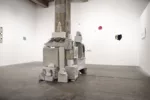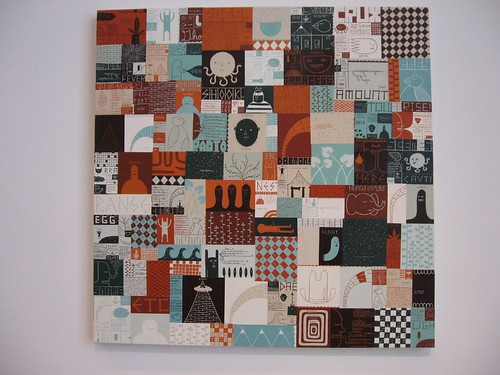
This Place is Ours!, by Jim Houser, acrylic on paper collaged on canvas, 40 x 40 inches
This is the age of aquarius over at the Pennsylvania Academy of the Fine Arts–harmony and understanding and three star-quality shows. At last the the place is living up to that name that came and then slunk off into the night; what was it, the Museum of American Art? The place not only has recovered from the folly of meaningless corporate branding at the same time that it has actually become that museum it dreamed it was.
So if you go there this summer, you will find not one great show, not two, but three, each of them worth the price of admission (although anything in the Morris Gallery is without an entry fee).
Numero Uno
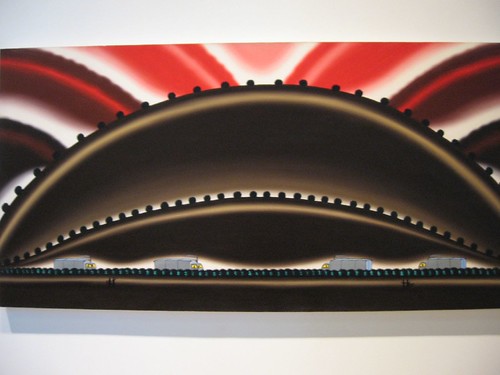
Roger Brown, detail of Michigan City Sand Dune Mt. Baldy, (I cut off the right hand edge; sorry), oil on canvas, 48 x 96 inches; this landscape is spectacular, merging the outsider qualities of Ray Yoshida, a fellow Chicago imagist, with a sort of Pop iconic spirituality about the land and the sky.
The biggest of the three, is a large exhibit of nearly 90 recent acquisitions made since 2001, most of them made since 2004. The title of the exhibit, This Place is Ours!, named after a work by Jim Houser, is a battle cry announcing a new regime, a new set of values at PAFA. Many of the pieces were purchased by PAFA curators Alex Baker and Robert Cozzolino. Cozzolino is the exhibit’s curator, and he puts together a high-quality show of exciting work. A big bite of it comes from Philadelphia, too, and for the most part its right up there with the most exciting work in the show. See who’s local who’s in the exhibit in thispost, although the final cut included a change or two.
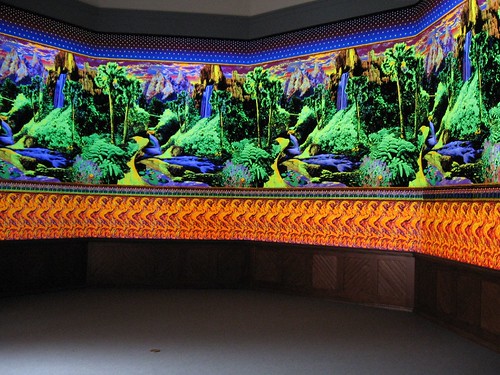
Virgil Marti, Landscape Wallpaper with Star Border and Shrooms and Flame Dado, fluorescent ink and rayon flock on Tyvek
Most of this exhibit is in the new Hamilton Building, with a couple in the Historic Landmark Building.–The Gross Clinic, by Thomas Eakins, Virgil Marti’s psychedelic black-light Landscape Wallpaper with Star Border and Shrooms and Flame Dado, originally created for the Morris Gallery.
Numero due
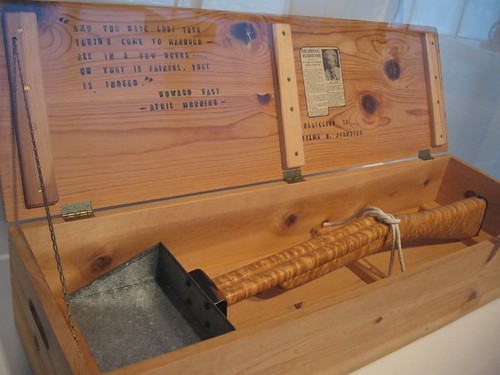
The Second Shotgun, 1977, pine, bird’s eye maple, ebony, granadillo (cocobolo), galvantized sheet metal, cotton rope, newspaper, brass chain, ink and leather bumpers, the Westermann piece PAFA acquired several years ago, is as good as Westermann gets.
The other exhibit in the Hamilton Building is work by H.C. Westermann. Dreaming of a Speech Without Words: the Paintings and Early Objects of H.C. Westermann, makes a great companion exhibit to This Place is Ours!, partially because the latter includes a fabulous Westermann–The Second Shotgun–acquired by Baker for PAFA in 2004.
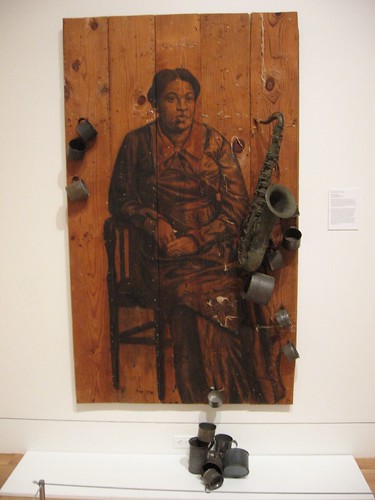
Whitfield Lovell, Gin Song, 2004, charcoal on wood with found objects (saxophone, metal cups); 77 1/4 x 45 7/16 x 17 inches
I want to link the Westermann work to Whitfield Lovell’s Gin Song, Jim Nutt’s I’m All A TWit (another of the Chicago crew), the Red Grooms bicycle and Isaac Resnikoff’s geode stool, all in This Place is Ours! But go, and you’ll find lots more to link between the shows.
Numero tre

Warp Trance, by Senga Nengudi, a video installation in the Morris Gallery, in collaboration between PAFA and the Fabric Workshop and Museum. photo by Roberta.
On a totally different note, the third exhibit in the Morris Gallery at PAFA, is the Fabric Workshop and Museum commissioned Nenga Sengudi video installation–wonderful, provocative, and we hope soon to appear as a Look! It’s Libby and Roberta video, so I’ll hold off commenting any further.
This Place is Ours!
I hardly know where to begin with This Place is Ours! So I’m just going to post some pictures and ramble a little.
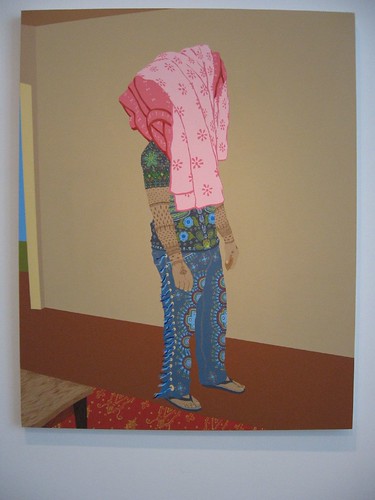
Eamon Ore-Giron, Exit Strategy, acrylic on canvas, 60 x 48 inches
Putting Eamon Ore-Giron’s Exit Strategy, with its focus on fabrics and a homey interior, next to Houser’s quilty collage/painting This Place is Ours! is a great call. Both are flat and quirky.
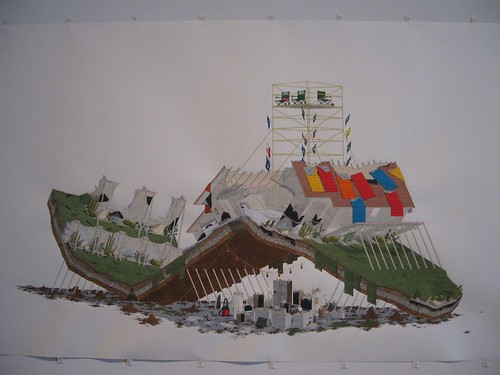
Ben Peterson, California Ten, Ink and graphite on paper; 58 x 108 inches
I also liked the placement of Roger Brown’s visionary landscape, Michigan City Sand Dune Mt. Baldy, near Ben Peterson’s apocalyptic California Ten landscape.
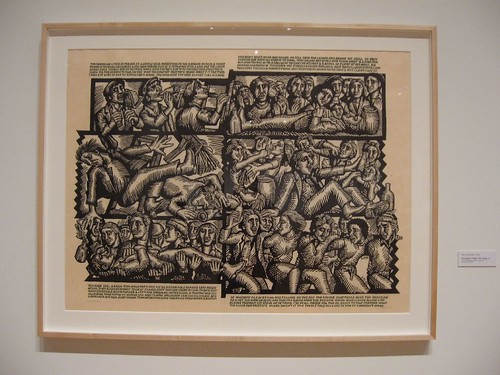
Peter Gourfain, Finnegan’s Wake, The Song, 1990, Linocut on Japanese paper; artist’s proof; 39 x 52 3/4 inches
Some other of an exhibit full of great groupings–Peter Gourfain near Huston Ripley, Art Green and Suellen Roca; a trio of trompe l’oeil paintings of money from John Frederick Peto, William Harnett and John Haberle; the entire minimalist group upstairs, including Astrid Bowlby between Bruce Pollack and Jennifer Bartlett; Kevin Finklea‘s ethereal pink next to Robert Ryman‘s ethereal white; and a Quentin Morris series of black circles next to Willie Cole’s scorched plywood piece, Branded Irons (which needed more viewing space).
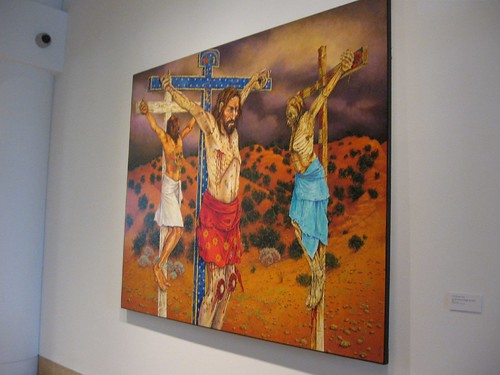
Paul Pletka, Los Hermanos de Sangre, acrylic on canvas, 78 x 96 inches
Speaking of shortness of space, Paul Pletka’s Los Hermanos de Sangre, an amazing painting merging bloody Christ imagery with native American subjects–one of them tatooed in biker-dude baroque–was cramped, a large painting in a narrow hall.
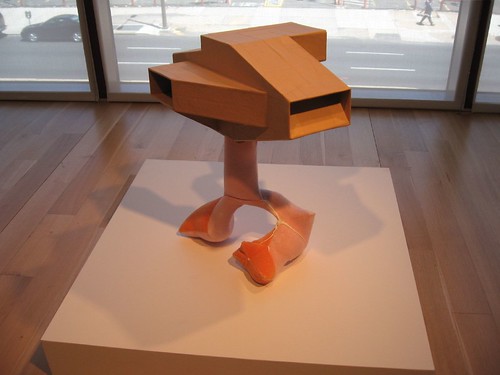
Tristin Lowe, untitled, 2004, cardboard, packing tape, plywood, plaster and fabric
The sculpture section, in the Tuttleman Gallery upstairs, included besides PAFA’s Westermann, the Nick Cave Soundsuit #26, a terrific Tristan Lowe what-is-it (untitled, of course), an Isaac Resnikoff stool, Betye Saar’s Blackbird, and the amazing cut paper piece by Jane South (Roberta’s photo here; I didn’t get one) and more…
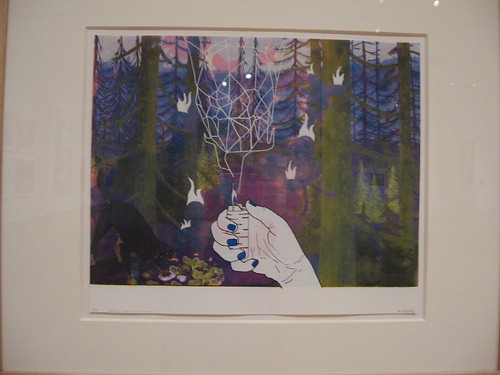
Joy Feasley, Wooley Bear Says “Ouch,” 2004, silkscreen on paper, 13 1/2 x 18 inches
Local artists still at it who I haven’t yet mentioned are Anthony Campuzano, Rob Matthews, Russell Sellers, Edna Andrade, Jane Irish and Joy Feasley, all looking good. I don’t think I’ve seen the Feasley before, with its sweet camper-girl loopiness.
H.C. Westermann
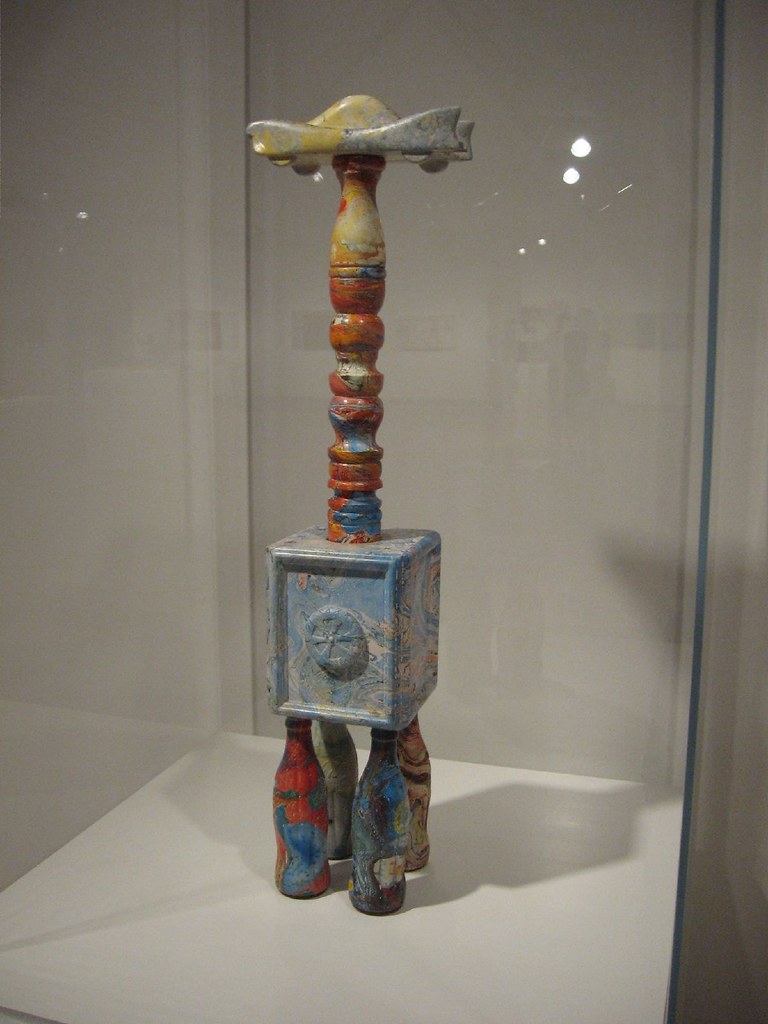
H.C. Westermann, Trophy for a Gasoline Apollo
The Westermann exhibit, Dreaming of Speech Without Words, with its mix of early sculptures and paintings and drawings, give a chance to get some background on a wonderful Chicago artist (1922-1981) with edgy insights into the materialistic and violent society around him. Although some of the drawings and paintings show his skill and dark sense of humor, it’s the sculptures, precursors of even more accomplished work yet to come, that steal the show.
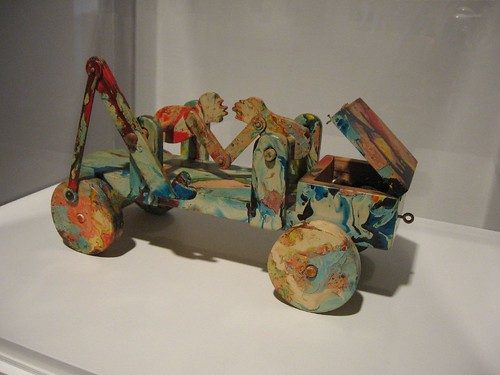
Using an unusual technique mixing oil paint and water together, he used the variegated finish on several wonderful pieces– a carved pistol he called Ray Gun, a muscle car raised high on a pedestal of coke bottles, and a sort of pull toy/music box with two figures who kiss and draw apart repeatedly as the sculpture rolls–a love note to his wife.

untitled (red lion), 1959, plywood, enamel and dowls, is a sign for a Chicago bar owned by a friend of Westermann’s. The same lion appears in one of his paintings.
A pair of low-key bas reliefs, one a sign–a red lion–and one a child-like silver rocket, also stole my heart.
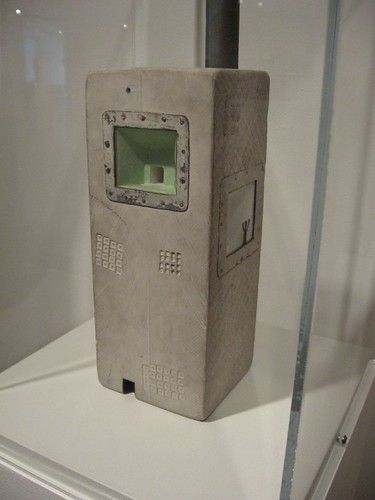
Austerility, 1957, wood, paint, glass, galvanized sheet metal and chrome pipe
Any number of boxes, Westermann’s specialty, were pretty interesting, from the complexities of Mad House to the simple Ensor’s Mother, in which an Ensor drawing of his mother asleep is nestled in a box, the words Ensor’s Mother carved in the top. Very creepy.
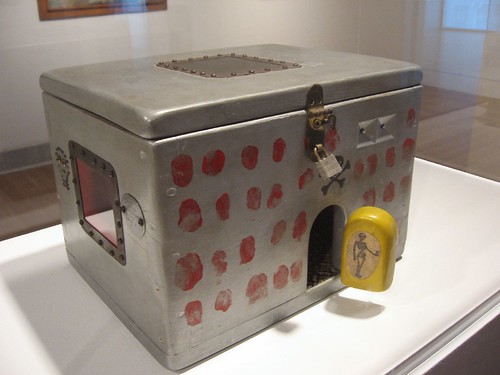
Westermann, Untitled (Unusual Physician), 1957, pine, metal, alumninum alkyd enamel, postcard and varnish
If you don’t know Westermann’s work, this is an opportunity to see it and fall in love. This Art Institute of Chicago-trained artist stays contemporary and fresh, with his acerbic, accessible wit. Dreaming, an exhibit of 70 pieces, was brought in by Baker from The Contemporary Museum, Honolulu, and curated by Michael Rooks.
How to catch all three shows at once
Westermann will remain up until Oct. 31, This Place is Ours will remain up until Sept. 23, and Senga Nengudi will remain up until Aug. 26. So get there in the next month.





